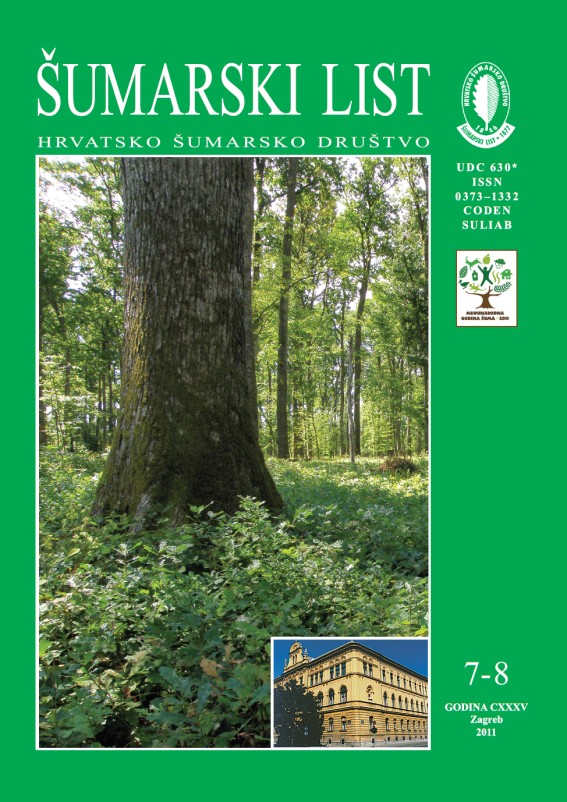
broj: 7-8/2011
pdf (5,9 MB) |
|
||||||||||||||
| RIJEČ UREDNIŠTVA | ||
| EDUCATION AND EMPLOYMENT pdf HR EN | 341 | |
| IZVORNI ZNANSTVENI ČLANCI | ||
| Jakovljević,T., M. Gradečki-Poštenjak, I. Radojčić Redovniković | UDK 630* 232.3 (Pinus pinea L.) (001) | |
| Physiological, Chemical andAntioxidant Properties of Fresh and Stored Stone Pine Seed (Pinus pinea L.) pdf HR EN | 343 | |
| PRETHODNO PRIOPĆENJE | ||
| Mihoci, I., M. Franjević | UDK 630* 453 | |
| Rare and Threatened Geometrid Moth Erannis ankeraria in Croatia: Historical Review, data Analysis & Perspectives pdf HR EN | 353 | |
| Kajba,D., J. Domac, V. Šegon | UDK 630* 537 + 238 | |
| Procjena potencijala brzorastućih nasada u Republici Hrvatskoj: Primjer razultata u sklopu FP7 projekta Biomass energy Europe pdf HR EN | 361 | |
| Summary: The overall objective of the FP7 Biomass Energy Europe – BEE project is to improve the accuracy and comparability of future biomass resource assessments for energy by reducing heterogeneity, increasing harmonisation and exchanging knowledge. One of the main results within the project is the development of the Methods Handbook for biomass potential assessment, which contains detailed description of the proposed methodology based on type of biomass and type of analysis (statistical, spatially explicit, integrated and others). The main objective of the Illustration case for Croatia performed within the BEE project is to estimate the energy and technical potential of fast-growing broadleaved species energy plantations on abandoned land or on land where agricultural production is not profitable. The methodology utilised is based on the BEE Methods Handbook. The main source of data used is contained within the Basic pedological map of the Republic Croatia, which forms the basis for the estimation of soil suitability for any kind of designated utilization. The theoretical potential for short rotation energy crops production in Croatia was estimated as following: • Forest area suitable for energy crops – a total of 51 200 ha was estimated to be suitable for SRC, producing in total 470 200 t DM/y or 8,7 PJ • Agricultural areas with moderately suitable soils and limited soil suitability – a total of 617 000 ha was estimated to be suitable for SRC, producing a total of 7 404 000 t DM/y or 136,2 PJ The technical potential for short rotation energy crops production in Croatia was estimated as following: • Forest area suitable for energy crops – a total of 46 850 ha was estimated to be suitable for SRC, producing in total 430 000 t DM/y or 7,9 PJ • Agricultural areas with moderately suitable soils and limited soil suitability – a total of 235 650 ha was estimated to be suitable for SRC, producing a total of 2 827 800 t DM/y or 52,1 PJ In spite of the considerable potential for short rotation energy crops production, currently a very small amount of the available area is utilised in Croatia. The issues and problems to be addressed in order to increase this production include a change in policy approach, especially aimed at small landowners, introduction of incentives and subsidies, lack of knowledge and experience in growing energy crops and generally a lack of cooperation between relevant stakeholders. Key words: Biomass Energy Europe; biomass potential assessment; short rotation crops | ||
| Kličić,H., S. Govorčin,T. Sinković, S. Gurda,T. Sedlar | UDK 630* 812 (Pinus sylvestris L.) | |
| Macroscopic Characteristics and Density of Scots Pine (Pinus Sylvestris L.) from Cazin, Bosnia and Herzegowina pdf HR EN | 371 | |
| STRUČNI ČLANCI | ||
| Barčić, D., N. Panić | UDK 630* 907 | |
| Ecological Valorisation of the ProtectedArea of “Kopački Rit” Nature Park pdf HR EN | 379 | |
| Mayer, Željko | UDK 630* 232 (Juglans nigra L.) | |
| Establishing Cultures of Black Walnut (Juglans nigra L.) by Generative Propagation pdf HR EN | 391 | |


